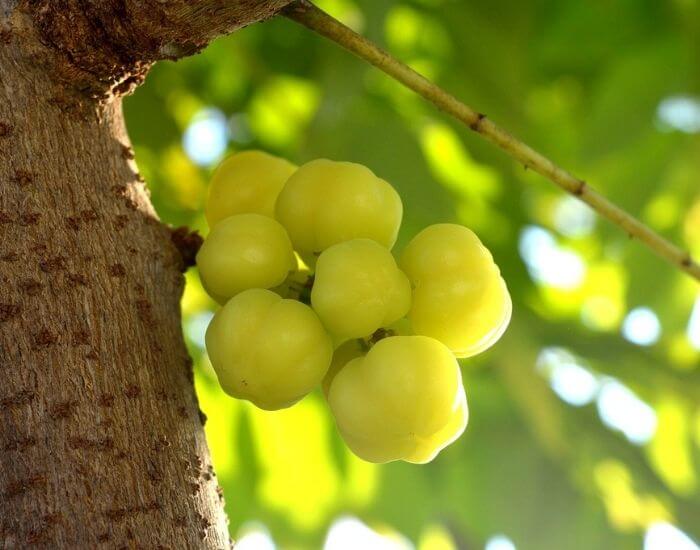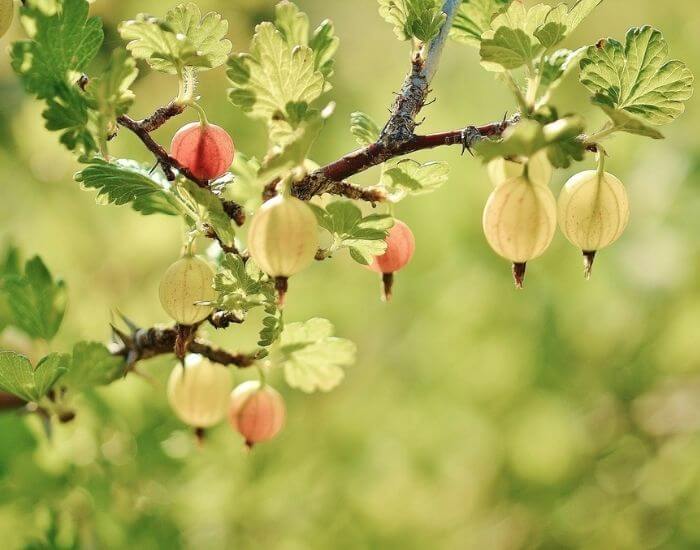When it comes to fruits, we often think of smooth, shiny surfaces that are pleasing to the touch. However, there exists a fascinating category of fruits that defies this norm – hairy fruits.
These peculiar specimens boast a distinctive exterior covered in hairs that give them an uncanny appearance. From the soft fuzz on peaches and apricots to the prickly strands enveloping coconuts, these fuzzy fruits have captured the curiosity of both botanists and fruit enthusiasts alike.
In this article, we will delve into the world of furry fruits, exploring their unique characteristics, origins, and even delving into the question of why exactly they developed such hairiness in the first place.
List of Hairy Fruits
1. Rambutan
Rambutan is a tropical fruit known for its distinctive appearance and sweet, juicy taste. The fruit is typically small to medium-sized and covered in a thick, hairy skin that can range in color from green to red.
The spiky hairs on the rambutan’s skin give it a unique texture and make it easily recognizable among other fruits.
Underneath the hairy exterior lies the white flesh, which is firm, yet tender. The flesh surrounds a single seed that is not edible and should be discarded before consuming the fruit.
When ripe, rambutans have a sweet flavor reminiscent of lychee or grapes, making them an enjoyable treat for those with a sweet tooth.
How to use rambutan
This hairy red fruit belongs to the same family as lychee and longan. Its name originates from the Malay word “rambut,” meaning hair, which aptly describes its unique appearance.
To use rambutan, start by making a small incision on the skin with a knife or your fingers. Gently peel back the skin to reveal the flesh underneath.
Rambutans are often enjoyed fresh as a snack or added to fruit salads for an exotic twist.
Besides being delicious on their own, rambutans can be used in various culinary creations.
You can also incorporate this red fruit with hair into desserts like sorbets, ice creams, or jellies for a delightful burst of sweetness. With its versatility and unique flavor profile, rambutan is indeed an exciting tropical fruit worth exploring in your kitchen!
2. Kiwi
One of the distinguishing features of kiwi fruit is its characteristic hairy exterior. The fuzzy brown skin not only adds to its unique appearance but also serves as a protective layer for the delicate green flesh inside.
This natural coating acts as a barrier against pests and helps to maintain the fruit’s freshness by reducing moisture loss.
The hairs or fuzz on a kiwi are actually called trichomes. They provide several benefits for this small brown hairy fruit.
Firstly, they act as a defense mechanism by deterring insects from feeding on the fruit. Additionally, trichomes can help reduce evaporation and protect against sun damage, keeping the kiwi fresh and juicy for longer periods.
The texture of kiwi skin may appear odd at first glance, but it plays an essential role in preserving this delectable fruit during its journey from farm to table. So next time you enjoy a juicy slice of kiwi, take a moment to appreciate those tiny hairs that contribute to its unique look and taste!
Kiwi uses
One popular use of kiwi is in smoothies and juices. The sweet and tangy flavor of this brown furry fruit blends well with other fruits, adding a refreshing twist to beverages.
Its vibrant green color also provides an attractive aesthetic appeal when used as a garnish or ingredient in cocktails.
Additionally, kiwi can be incorporated into desserts and baked goods. The natural acidity of the fruit makes it an excellent tenderizer for meat dishes, especially when used as a marinade or added to salsa.
Kiwi can also be preserved by making jams, jellies, or chutneys, which can be enjoyed spread on toast or paired with cheese.
3. Coconut
One of the most iconic hairy fruits is the coconut. This tropical delight is not only famous for its distinct outer covering but also for its versatility and benefits.
The husk is covered in long, fibrous strands that give it a unique hairy appearance. These fibers not only protect the inner meat and water but also make it easier to grip and open.
Coconut trees are abundant in many tropical regions, making them an essential part of the local culture and cuisine. The meaty flesh inside the coconut is rich in healthy fats, vitamins, and minerals.
Coconut uses
One common use for coconuts is in the kitchen. The flesh of the coconut can be grated and used in various recipes such as curries, desserts, and smoothies.
Additionally, coconut oil extracted from the fruit is highly versatile and can be used for cooking, baking, skincare products, hair treatments, and even as a natural sunscreen.
Apart from culinary uses, coconuts have many practical applications as well. The sturdy outer shell of the coconut can be transformed into various household items such as bowls, utensils, buttons, and decorative accessories.
In some cultures with ample access to coconuts, people even use the husks as fuel for fire or create ropes by weaving them together. Moreover, coconut fiber extracted from the husk is commonly used to make mats and ropes due to its durability.
4. Hairy Eggplant
Another intriguing addition to the world of fruits with hair is the hairy eggplant. With its unique appearance and texture, this exotic fruit has gained popularity among food enthusiasts seeking new culinary experiences.
The hairy eggplant gets its name due to the fine layer of tiny hairs that cover its skin, giving it a velvety and fuzzy exterior.
Underneath the hairy exterior lies an orange-yellow flesh that is incredibly tender and juicy. Note the many seeds.
What do hairy eggplants taste like? They are known for their distinctive tropical taste.
Hairy eggplant uses
In many places, this yellow hairy fruit is widely used to prepare delicious stews and curries due to its distinct flavor and texture.
Additionally, hairy eggplant can be eaten raw. You can store these furry fruits for up to a week.
5. Peach
Peaches are one of the many hairy fruits found in nature. The fuzz or velvety texture covering the skin of a peach is not only unique but also serves a purpose.
This fuzzy layer acts as a natural protective barrier, shielding the fruit from external threats such as insects and fungi. It also helps to retain moisture within the fruit, preventing it from drying out.
Moreover, the hair-like structures on peaches play a vital role in enhancing their flavor and aroma.
These tiny hairs trap volatile compounds released by the fruit, creating a more intense fragrance and taste.
Additionally, when ripe, peaches become soft to the touch due to enzymes breaking down cell walls within the fruit. This enzymatic action can sometimes cause these hairs to detach from the skin easily.
Peach uses
The sweet and tangy flavor of peaches adds a delightful touch to many dishes, such as salads, salsas, and desserts. They can be sliced and added to fruit salads or grilled for a caramelized twist.
Peach preserves and jams are also commonly made to enjoy on toast or biscuits.
In addition to their culinary applications, peaches have several uses in skincare products.
Overall, hairy fruits like peaches offer more than just a tasty treat; they bring versatility and benefits that extend beyond consumption alone.
6. Camellia fruit
Camelia fruit is a unique and intriguing addition to the world of fruits. It has a distinctive layer of fine hairs covering its outer skin.
These tiny hairs give it a fuzzy appearance, similar to that of a peach or kiwi. These fruits are borne by camellia plants. Their interior boasts of 2-5 large brown seeds.
The seeds are consumed by birds such as blue jays. Fruiting is in September to October.
7. Green Almonds
Green almonds are small and green with a fuzzy outer layer. These hairy fruits can be found on almond trees during the early stages of development.
The fuzz serves as a protective layer for the young fruit, shielding it from harsh environmental conditions such as extreme temperatures and pests.
As the young almond fruit matures, the hairy layer gradually dries out and falls off, revealing a smooth outer shell.
This transition is an indicator that the fruit is nearing its harvest stage.
Green almond uses
Green almonds are a unique delicacy that is not widely known. These hairy fruits are harvested before they fully mature and harden, offering a distinct flavor and texture.
While most people are familiar with the taste of roasted almonds, green almonds provide a completely different experience. The soft and tangy flesh inside the fuzzy exterior offers a delightful crunch, making them perfect for snacking.
Apart from their delectable taste, young almond fruits have several culinary uses. They can be pickled to create a savory and tangy condiment that pairs well with various dishes.
Pickled green almonds add an acidic punch to salads or can be enjoyed as a garnish on sandwiches or cheese platters. Additionally, these unique fruits can be incorporated into sauces and dips to give them an extra zing of flavor. Their versatility makes them an exciting ingredient in both sweet and savory recipes.
8. Yellow Jabuticaba
Yellow jabuticaba is a type of fruit that belongs to the Myrtaceae family. It is known for its unique and interesting appearance, as it is covered in a layer of fine hairs.
These hairs give the fruit a fuzzy texture and make it stand out among other fruits in its family. The yellow jabuticaba is native to Brazil and can be found growing in tropical regions.
The hairy exterior of the yellow jabuticaba serves several purposes. Firstly, it acts as a protective layer, shielding the fruit from potential damage or pests. Additionally, the hairs help to trap moisture around the fruit, which helps to prevent dehydration and maintain its freshness.
Despite its hairy appearance, this small hairy fruit has a delicious taste that is often described as sweet and tangy. The flesh inside is juicy. It has one seed.
In addition to its unique texture and taste, the yellow jabuticaba also offers several benefits.
Yellow jabuticaba uses
First and foremost, jaboticaba is most commonly enjoyed fresh off the tree as a delicious snack or used in an array of culinary creations.
Its sweet-tart flavor profile makes it a perfect addition to jams, jellies, desserts like pies and cakes, as well as beverages such as juices and liqueurs.
Final Thoughts:
Hairy fruits may not be the most common or aesthetically pleasing type of fruit, but they certainly have their own unique qualities. From the soft, fuzzy texture to the vibrant colors and interesting shapes, these fruits offer a sensory experience unlike any other.
Additionally, their high nutrient content makes them worth exploring for those looking to diversify their diets. So next time you come across a hairy fruit at the grocery store or farmer’s market, don’t be afraid to give it a try.
Who knows, you may just discover a new favorite fruit that adds some excitement and novelty to your meals.
sources:
Hi There,
My name is Jenny. I’m the Chief Editor at Try Green Recipes and besides making yummy and healthy foods for my kids, grandkids, and friends. I’m new to the blogging world but I believe what I have to share is unique and will bring joy to your home. If you are adventurous and want try something tasty, let’s get started.

